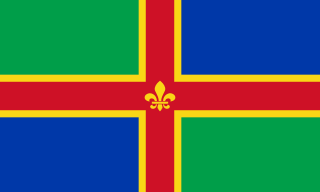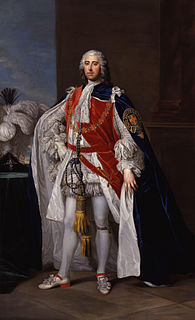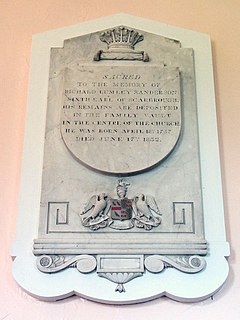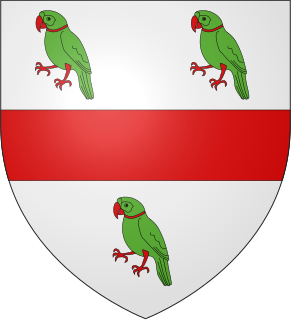Richard Lumley-Saunderson, 4th Earl of Scarbrough PC (May 1725 – 12 May 1782) was a British peer, styled Viscount Lumley from 1740 to 1752. [1]
A peerage is a legal system historically comprising hereditary titles in various countries, comprising various noble ranks.
He was appointed a deputy lieutenant of the West Riding of Yorkshire on 4 August 1757. On 27 October 1759, he was appointed colonel of the North Lincolnshire battalion of militia, and was made a deputy lieutenant of Lincolnshire on 30 November 1761. [1]

The West Riding of Yorkshire is one of the three historic subdivisions of Yorkshire, England. From 1889 to 1974 the administrative county, County of York, West Riding, was based closely on the historic boundaries. The lieutenancy at that time included the City of York and as such was named West Riding of the County of York and the County of the City of York.

Lincolnshire is a county in eastern England, with a long coastline on the North Sea to the east. It borders Norfolk to the south east, Cambridgeshire to the south, Rutland to the south west, Leicestershire and Nottinghamshire to the west, South Yorkshire to the north west, and the East Riding of Yorkshire to the north. It also borders Northamptonshire in the south for just 20 yards (18 m), England's shortest county boundary. The county town is the city of Lincoln, where the county council has its headquarters.
Scarbrough was Cofferer of the Household and deputy Earl Marshal from 1765 to 1766, and was sworn of the Privy Council in 1765. [1]

The Cofferer of the Household was formerly an office in the English and British Royal Household. Next in rank to the Comptroller, the holder paid the wages of some of the servants above and below stairs, was a member of the Board of Green Cloth, and sat with the Lord Steward in the Court of the Verge. The cofferer was usually of political rank and always a member of the Privy Council.

Earl Marshal is a hereditary royal officeholder and chivalric title under the sovereign of the United Kingdom used in England. He is the eighth of the Great Officers of State in the United Kingdom, ranking above the Lord High Constable and beneath the Lord High Admiral.
He married Barbara, the daughter of Sir George Savile, 7th Baronet. He was succeeded in turn by his sons George Lumley-Saunderson, 5th Earl of Scarbrough, Richard Lumley-Saunderson, 6th Earl of Scarbrough, and John Lumley-Savile, 7th Earl of Scarbrough.

Sir George Savile, 7th Baronet of Thornhill FRS, of Rufford Nottinghamshire, was an English politician who sat in the House of Commons from 1728 to 1734.
George Augustus Lumley-Saunderson, 5th Earl of Scarbrough, styled Viscount Lumley until 1782, was a British peer and politician who sat in the House of Commons from 1774 to 1780.

Richard Lumley-Saunderson, 6th Earl of Scarbrough, styled The Honourable Richard Lumley-Saunderson until 1807, was a British peer and politician.







